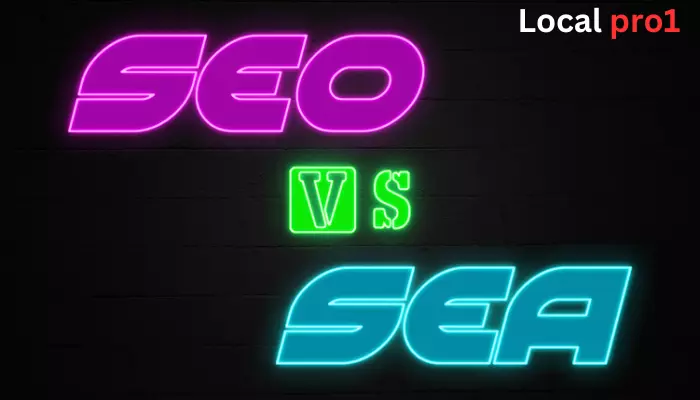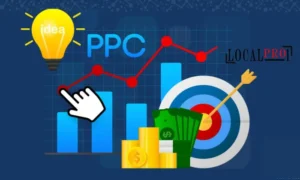Local SEO Services Near Me | Local Pro1 Welcome to...
Competing for Clicks: SEO vs. SEA Demystified
Competing for Clicks: SEO vs SEA Demystified
In the digital realm, SEO (Search Engine Optimization) stands as the strategic process of refining a website’s content, structure, and backend elements to improve its visibility in organic search engine results. Conversely, SEA (Search Engine Advertising) encompasses the paid aspect of online visibility. Localpro1 provides the best SEO VS SEA services as you dreamed of. When comparing SEO vs SEA, it’s crucial to understand their distinct roles in enhancing online presence.

What is SEO and SEA
Purpose and Goals of SEO
Visibility and Traffic: SEO aims to enhance a website’s visibility in search engine results pages (SERPs) to attract organic (unpaid) traffic.
Relevance and Authority: It focuses on making the website more relevant and authoritative for specific search queries, ultimately improving its ranking.
Techniques and Strategies of SEO
On-Page Optimization: Involves optimizing content, meta tags, headings, and website structure.
Off-Page Optimization: Building backlinks, social media signals, and online reputation management.
Technical SEO: Improving site speed, mobile-friendliness, and enhancing crawlability for search engine bots.
Benefits and Limitations of SEO
Benefits:
- Long-term sustainable traffic.
- Cost-effective in the long run.
- Builds trust and credibility.
Limitations:
- Results can take time to reflect.
- Algorithm changes can impact rankings.
- Requires ongoing effort to maintain and adapt strategies.
Purpose and Goals of SEA
Immediate Visibility: SEA aims for immediate visibility by displaying paid ads in search engine results.
Targeted Reach: It focuses on reaching specific audiences based on chosen keywords and demographics.
Techniques and Strategies of SEA
Keyword Bidding: Choosing and bidding on keywords relevant to the target audience.
Ad Creation: Crafting compelling ad copies with engaging visuals or text to attract clicks.
Ad Campaign Management: Monitoring, adjusting bids, and optimizing ad campaigns for better performance.
Benefits and Limitations of SEA
Benefits:
- Immediate results and visibility.
- Control over ad placement and budget.
- Highly measurable with clear ROI.
Limitations:
- Costly, especially with competitive keywords.
- Results stop when the ad spend stops.
- Ad blockers or ad fatigue can reduce effectiveness.
Difference between SEO and SEA
Organic vs Paid Search
SEO: Focuses on optimizing a website to rank organically in search engine results without direct payment for clicks.
SEA: Involves paying for ad placements within search engine results to achieve immediate visibility.
Cost Structure and Management
SEO: Primarily entails initial setup and ongoing optimization efforts, often with an in-house team or hired specialists.
SEA: Operates on a pay-per-click (PPC) model, where advertisers pay for each click on their ads, requiring continual budget management.
Timeframe and Results
SEO: Results take time to materialize, often requiring several months to see significant improvements in rankings and traffic.
SEA: Provides immediate visibility and results, with ad placements appearing as soon as the campaign is launched.
Methodologies and Implementation
Keyword Research and Usage
SEO: Involves extensive keyword research to optimize website content and align it with user search queries.
SEA: Requires strategic selection and bidding on keywords to trigger ad placements in search engine results.
Ranking Factors and Algorithms
SEO: Focuses on various ranking factors like quality content, backlinks, site structure, and user experience to improve organic ranking.
SEA: Depends on bidding strategies, ad relevance, click-through rates, and landing page experience to achieve better ad placement.
Target Audience and Reach
SEO: Targets a broad audience based on relevant content, aiming for sustainable organic traffic growth over time.
SEA: Allows for precise audience targeting based on demographics, behaviors, and search intent, ensuring specific ad reach to selected groups.
The Combination of SEO and SEA
Synergies and Benefits
Amplifying Online Presence
Synergies: Integrating SEO and SEA expands visibility on search engine results pages, occupying both organic and paid placements.
Benefits: Maximize exposure, capturing user attention across various sections of the search results page.
Enhanced Targeting and Conversion
Synergies: Utilizing both strategies enables precise audience targeting through SEO-driven content and SEA’s demographic-focused ads.
Benefits: Increases the likelihood of reaching the right audience at different stages of their buyer’s journey, improving conversion rates.
Comprehensive Marketing Strategy
Synergies: Combining SEO and SEA forms a holistic digital marketing approach, complementing each other’s strengths.
Benefits: Creates a more robust and versatile strategy, utilizing both long-term organic growth and immediate paid visibility.
Best Practices for Integration
Coordination and Alignment
Strategy: Align SEO and SEA efforts by coordinating keyword research and aligning content strategies.
Benefits: Ensures consistency in messaging, keywords, and overall brand representation across paid and organic channels.
Leveraging Data and Insights
Strategy: Share and analyze data between SEO and SEA campaigns to identify trends and optimize performance.
Benefits: Enables informed decision-making, allowing adjustments to maximize ROI and refine targeting strategies.
Testing and Optimization
Strategy: Continuously test and optimize SEO and SEA campaigns independently and in conjunction.
Benefits: Drives continuous improvement, refining strategies based on performance data and market changes, ensuring maximum impact and efficiency.
Advantages and Disadvantages of SEO vs SEA
SEO Pros and Cons
Long-term Sustainability
Pros: Establishes lasting credibility and visibility with consistent effort.
Cons: Takes time to yield significant results and requires ongoing maintenance.
Organic Traffic Generation
Pros: Generates free, sustainable traffic over time.
Cons: Slower to produce results; requires continuous optimization.
Time-Intensive and Evolving Algorithms
Pros: Adapts to evolving search algorithms for relevance.
Cons: Time-consuming; requires staying updated with changing algorithms.
SEA Pros and Cons
Immediate Visibility and Control
Pros: Offers instant visibility upon campaign launch.
Cons: Requires continual ad spend for ongoing visibility.
Cost Efficiency and Measurable ROI
Pros: Allows precise budget control and offers measurable returns.
Cons: Can become costly, particularly in competitive markets.
Dependency on Budget and Competition
Pros: Allows flexibility in adjusting budgets for competitive bids.
Cons: High competition can escalate costs and make visibility challenging without significant budgets.
Conclusion
In the dynamic landscape of digital marketing, SEO vs SEA highlights the distinct yet complementary approaches to achieving online visibility and engagement. SEO, with its focus on organic strategies, offers a foundation built on long-term sustainability, fostering credibility and generating enduring organic traffic. Feel free to contact us for any type of query or the services related to SEO vs SEA.
FAQs
What Is The Fundamental Difference Between Seo And Sea?
SEO (Search Engine Optimization) focuses on optimizing a website to improve its organic visibility in search engine results, while SEA (Search Engine Advertising) involves paying for ad placement in search engine results to gain immediate visibility.
Which Strategy, Seo Or Sea, Provides Quicker Results?
SEA typically provides quicker results as ads appear instantly after campaign launch, whereas SEO takes time to yield significant improvements, often requiring months to show substantial results.
Are There Ongoing Costs Associated With Seo And Sea?
SEO generally requires ongoing efforts for maintenance and optimization but doesn’t incur direct costs for placement in search results. In contrast, SEA involves continual costs, as advertisers pay each time someone clicks on their ad.
How Do Seo And Sea Impact Website Traffic Differently?
SEO generates organic traffic by optimizing a website’s visibility in search results, whereas SEA drives traffic through paid advertisements, which appear prominently in search results based on bids and relevance.
Which Strategy Is Better For Long-Term Growth?
SEO is known for its long-term sustainability, as it builds organic traffic and credibility over time. While SEA offers immediate visibility, it typically requires ongoing investment for sustained results.
Can Seo And Sea Strategies Be Used Together?
Yes, integrating SEO and SEA can create a comprehensive digital marketing strategy. Combining both allows for immediate visibility through paid ads (SEA) and long-term sustainable growth through organic visibility (SEO).
Our Services
Our Latest Posts
PPC White Label Services by Local Pro1 | Expert Solutions
PPC White Label Services by Local Pro1 | Expert Solutions...



